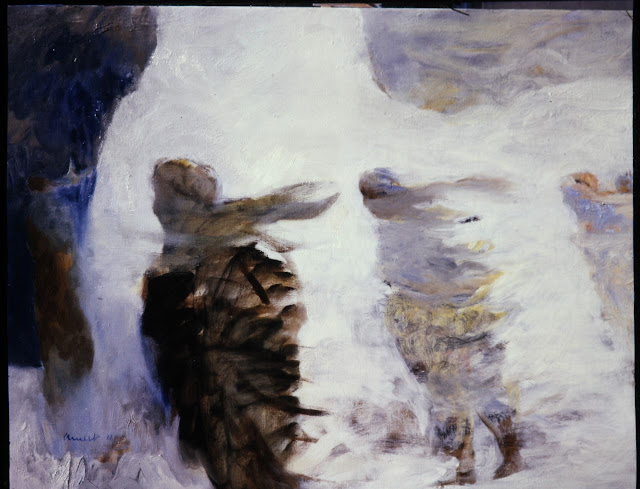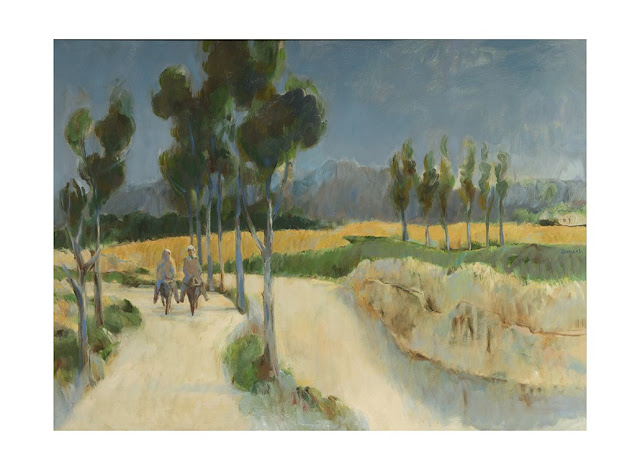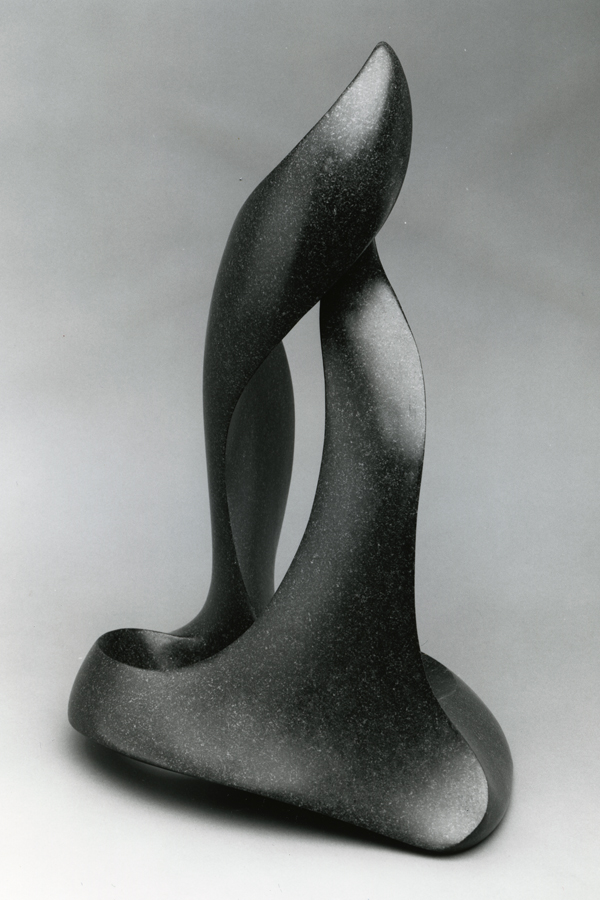Continuing our posts on various artists who exhibited at Lehigh University's Art Galleries, we now focus on Bernard Arnest whom Francis Quirk brought to the University in 1964.
Interestingly, Arnest had representation from the Kraushaar Gallery in New York who represented a number of other artists who exhibited at Lehigh including Raphael Soyer and Ruth Gikow. Interestingly, there are some similarities among these three artists' styles. This, in turn, gives us an indication os the gallery owner's tastes and those of its New York clientel. We know that there was an ongoing relationship between Quirk and the gallery.
 |
| Lehigh University's Brown and White blurb on Bernard Arnest and Raymond Mintz 1964 exhibit |
Biography of Bernard Arnest
 |
| Bernard Arnest 1940 |
Born in
Denver in 1917, Arnest attended East High
School, where he studied with its longtime art teacher, Helen Perry who was
influential in the education of several successful artists. Herself a student
of André Lhote in Paris, Perry for many years maintained a high standard in the
Denver Public Schools.
Before attending East,
Arnest wanted to study piano. However, in high school drawing class he
discovered his aptitude for art. At Perry’s recommendation he benefited from
supplemental instruction at the newly founded Kirkland School of Art and at the
school of fine art and design operated in downtown Denver.
The initial public recognition
of Arnest’s artistic talent occurred at East when he was the first-place winner
of the Charles Milton Carter Memorial Prize. The prize earned him a prominent
place in an exhibition—along with fellow runners-up—at Chappell House, the
first home of the Denver Art Museum.
Following graduation from
East, Arnest enrolled at the Broadmoor Art Academy in Colorado Springs, where
he studied with Boardman Robinson and Henry Varnum Poor from 1935-37 and
1938-39. It was the state’s leading art school with a national reputation, and
it attracted a diverse student body, including a large percentage of women
artists.
Several of Arnest’s
small-format paintings from this time depict scenes of harvesting and cattle
ranching. He was a skilled draftsman emphasizing the subjects’ rhythmic curves
and movements.
The institution’s leading
mural instructors were Robinson and Mechau, had an enviable success record in
winning government mural competitions. From 1936 to 1940 students, faculty and
alumni executed 60 murals.
 |
| Settlers on the Texas Plains By Bernard Arnest 1940 |
A 1940 oil on canvas, Arnest’s WPA-era mural
was installed in the post office at Wellington, Texas, where it can still be
seen. He painted it while in Colorado Springs in the late 1930s.
Photo by Philip Parisi for
his book "The Texas Post Office Murals," 2004, courtesy Texas
A&M University Press
Arnest won the commission
for the post office in Wellington, Texas, in 1939 and the following year
installed the completed mural, where it remains in its original location.
Titled Settlers on the Texas Plains and executed in a combination of tempera
and oil on canvas, the mural shows Texans building a shelter and sowing crops
on the area plains, “fundamental activities,” in his words, “of opening and
using a new land.”
He also submitted a mural
design of a cattle drive in the Texas Panhandle to the Amarillo post office competition
but did not get the commission. In addition to his own mural painting, he and
two other students assisted Robinson with his eighteen-panel mural for the
Department of Justice in Washington, D.C., depicting portentous moments and
leading figures in the history of law. After completing his studies, Arnest
briefly served as Robinson’s teaching assistant.
 |
| Bernard Arnest on ladder working on a mural for Boardman Robinson |
Boardman Robinson’s students at the school of
the Colorado Springs Fine Arts Center assist him in the mid-1930s with his
murals collectively titled "Great Events and Figures of the Law." The
murals were installed at the Department of Justice in Washington, D.C. The
student on the ladder is Bernard Arnest; standing is David Fredenthal. Photo by
Laura Gilpin.
© 1979 Amon Carter Museum of
American Art, Fort Worth, Texas.
In 1940 the John SimonGuggenheim Memorial Foundation awarded Arnest a fellowship in painting. He used
it to do creative painting in San Francisco and to experience the city’s
thriving art scene that included the San Francisco Museum of (Modern) Art. There
Arnest visited the Picasso retrospective in 1940. That same year the museum
mounted Arnest’s one-man show, the first of a number in his professional
career.
After the Japanese bombing
of Pearl Harbor in December 1941, Arnest enlisted with the Army Signal Corps.
Commissioned a Second Lieutenant a year later, he served for nine months in
Iceland in 1943 and then with the Tenth Replacement Depot in England before
joining a five-man team of artists in 1944 attached to the History Section of
the US Army’s European Theater of Operations. The section was established to
collect information for use in the official American history of the war to be
written and published after the end of hostilities.
Arnest served as the
section’s Chief War Artist through the war’s end. He worked in England, France,
Germany, Belgium, and the Netherlands, sketching and painting vignettes of
American Army life, the famous bridge at Remagen, Buchenwald concentration camp
prisoners, the meeting of Soviet and American troops at Strehla on the Elbe
River in 1945, and the ruins of bombed-out cities in which civilians tried to
survive. He also won a Bronze Star for helping a rescue mission near a
minefield in Aachen, Germany.
 |
| Untitled (Wounded Soldier) pen and ink wash by Bernard Arnest |
After the war he worked for
two years in New York City, believing that every artist should spend at least
one year there. During that time, he began a thirty-nine-year affiliation with
Kraushaar Galleries. In addition to acquainting himself with the new postwar
developments in American art, he traveled up and down the East Coast painting
scenes from North Carolina to New Hampshire.
In 1947 as his money was
running out, he fortuitously received a job offer from the Minneapolis School
of Fine Arts (since 1970, Minneapolis College of Art and Design—MCAD). Shortly
after Arnest assumed his instructor of painting position in 1949, the
Minneapolis Institute of Arts gave him a one-man show of rural and urban
landscape paintings and drawings of East Coast and wartime European subjects.
 |
| Red Barn Bernard Arnest 1949 Minnesota Historical Society |
Arnest’s service as an
artist in the US Army helped him earn the commission in 1955 to paint a
three-panel mural in the west lobby of the new Veterans Service Building on the
grounds of the state capitol in Saint Paul, Minnesota. He based the composition
depicting modern combat conditions on his wartime sketches and paintings with
texts beneath the images excerpted from President Abraham Lincoln’s Gettysburg
Address.
 |
Bernard Arnest Mural Veterans Service Building St. Paul, Minnesota 1955
Mural in situ. |
 |
Bernard Arnest Mural Veterans Service Building St. Paul, Minnesota
Close up of Mural |
The Lincoln quote reads "It is for us, the living, to be dedicated here to the unfinished work, which they how fought here have thus far so nobly advanced."
 |
| Close up of Bernard Arnest Mural Veterans Service Building St. Paul, Minnesota 1955 |
 |
| Close up of Bernard Arnest Mural Veterans Service Building St. Paul, Minnesota 1955 |
|
 |
| Close up of Bernard Arnest Mural Veterans Service Building St. Paul, Minnesota 1955 |
We thank Mark Arnest for graciously providing the photos. We have not been able to determine if the mural is still in situ. Mark keeps a facebook page on Arnest.
Arnest's mural is interesting as the viewer can see elements of both his technical excellence and his willingess to move into the abstract. The figures in the mural are well drawn, yet they are placed in environments with bright to garish patches of color. These colorful abstract background patches convey the sense of damaged buildings. There is a hint of combat in the left section, soldiers milling in the largest central portion and medics carrying a soldier on a stretcher in the third. This is not the type of mural that one would expect in a veterans building in 1955. For that era, the mural is cutting edge. It is worth noting that a "Promise of Youth" fountain that was to be placed in the building was the subject of significant controversy. So it may be concluded that the modernist architect Brooks Caven was willing to push the boundaries.
The following year the First National Bank engaged Arnest to paint an abstract mural for its bank branch (now closed) at the Southdale Center, the nation’s first indoor regional shopping mall, which opened in 1956 in Edina, Minnesota.
After completing the spring semester at the University of Minnesota
in 1957, Bernard Arnest relocated the family to Colorado Springs to join
Colorado College its faculty as professor and chairman of the art department. He
also was a principal consultant for the Advanced Placement in Art program
developed by the College Entrance Examination Board. In the early 1960s he also
served as a consultant on college and university art programs at Stanford
University, Pennsylvania State University, and the Ford Foundation.
in 1960 as a US Department of State consultant for its
international educational/cultural exchange program and receiving a grant to
depict the landscape and people of Afghanistan under the auspices of the US
Embassy in Kabul. There, he lectured in English before select groups and traveled
around the country making field sketches. He executed several paintings in the
country that made up his solo show at the American Exhibition at Kabul’s 1960 Afghan
National Fair. Some of those works along with others he finished after
returning to Colorado Springs were exhibited later at the Design Center and Art
Galleries in Denver and at Lehigh University.
The 1964 Lehigh University exhibition of Aarnest's paintings from Afghanistan also included those of Raymond
Mintz in an exhibition organized by Francis Quirk. This was not the first time Bethlehem,
Pennsylvania saw Arnest's work. Earlier in 1957, one of his paintings joined
those of Edward Hopper, James Penney and others in another Lehigh exhibition.
We provide a selection of Arnest's Afghanistan paintings below. We cannot fully confirm that these were the actual,s specific paintings exhibited at Lehigh at the time. However, we do believe that these are a representative sample. In the works, one can again see both the technical skill and a willingness to creatively use color and shape in a more fluid manner.
 |
| Afghans Resting by Bernard Arnest Photo courtesy of Mark Arnest |
 |
| Afghan Family by Bernard Arnest Photo courtesy of Mark Arnest |
 |
| Afghan Seated by Bernard Arnest Photo courtesy of Mark Arnest |
|
 |
| White Wind by Bernard Arnest Photo courtesy of Mark Arnest |
 |
| Wheat Field by Bernard Arnest Photo courtesy of Mark Arnest |
Arnest retired from
Colorado College in 1982 as professor emeritus of art, a step he felt he should
have taken some forty years earlier. While he enjoyed teaching, he welcomed the
lack of schedules and deadlines, leaving him free to paint and do a little
writing.
He died in 1986.





 Victor Riu Resurgent Harmony 1957 Photo courtesty of the Philadelphia Academy of Fine Art
Victor Riu Resurgent Harmony 1957 Photo courtesty of the Philadelphia Academy of Fine Art

































